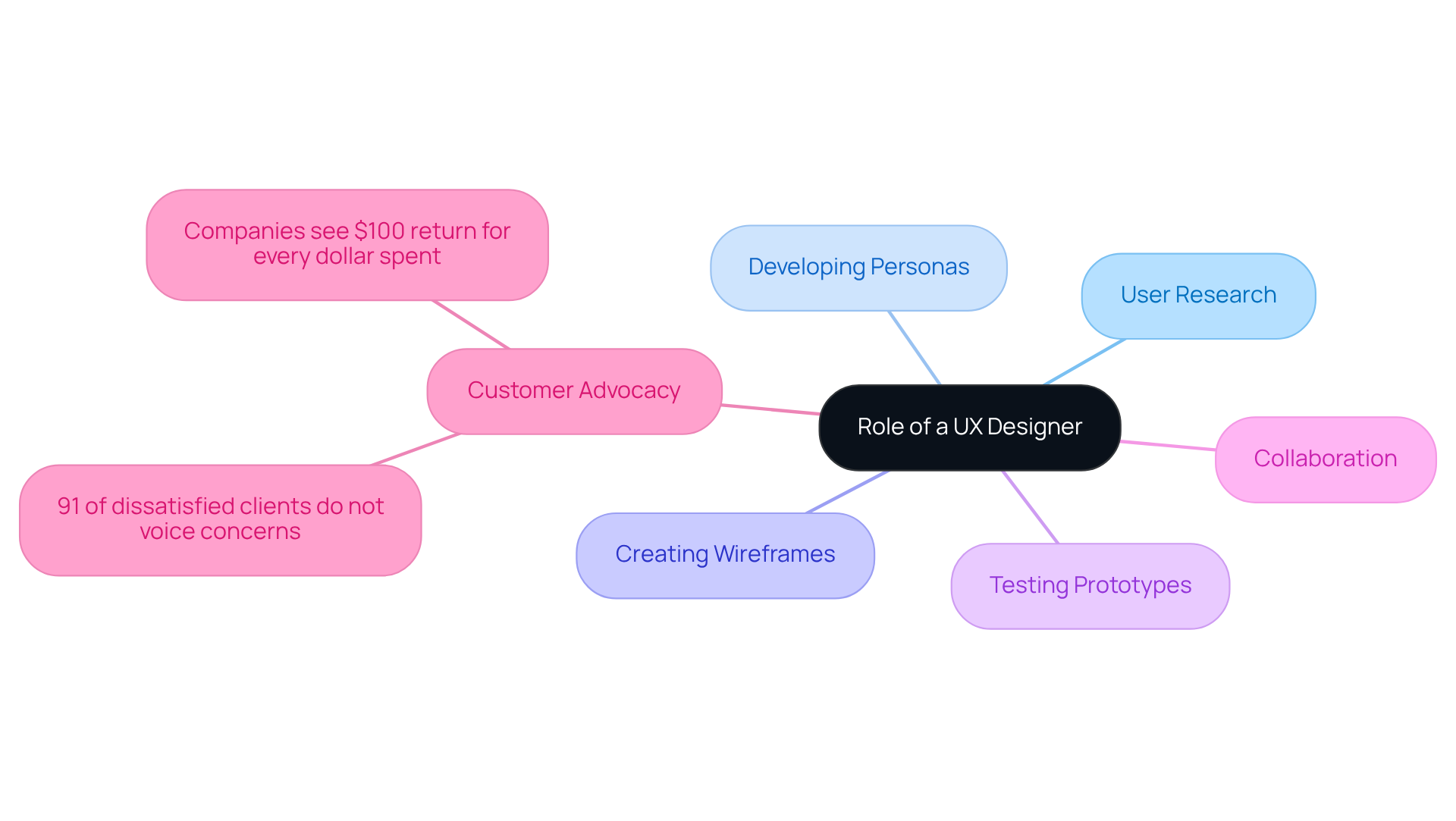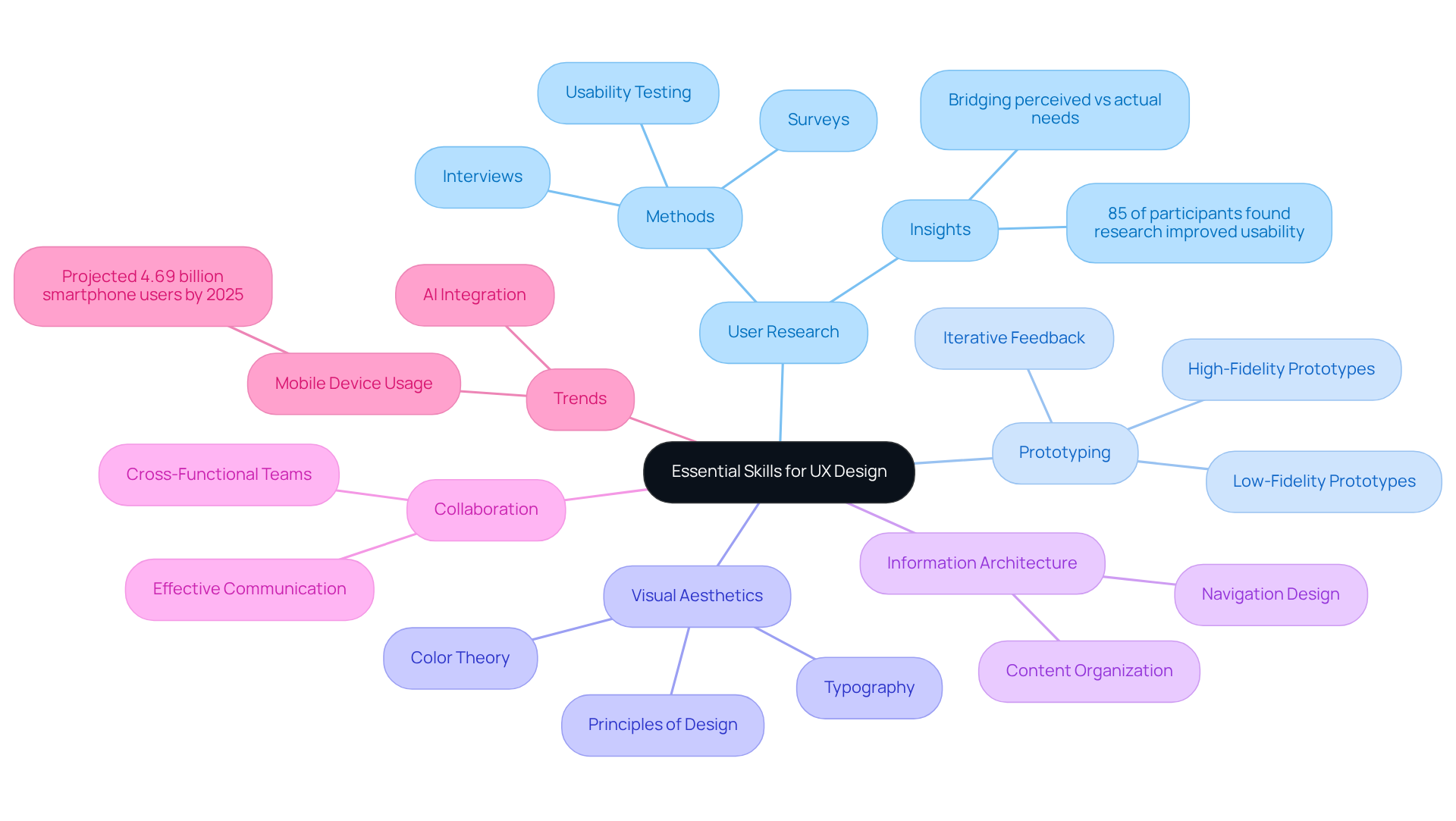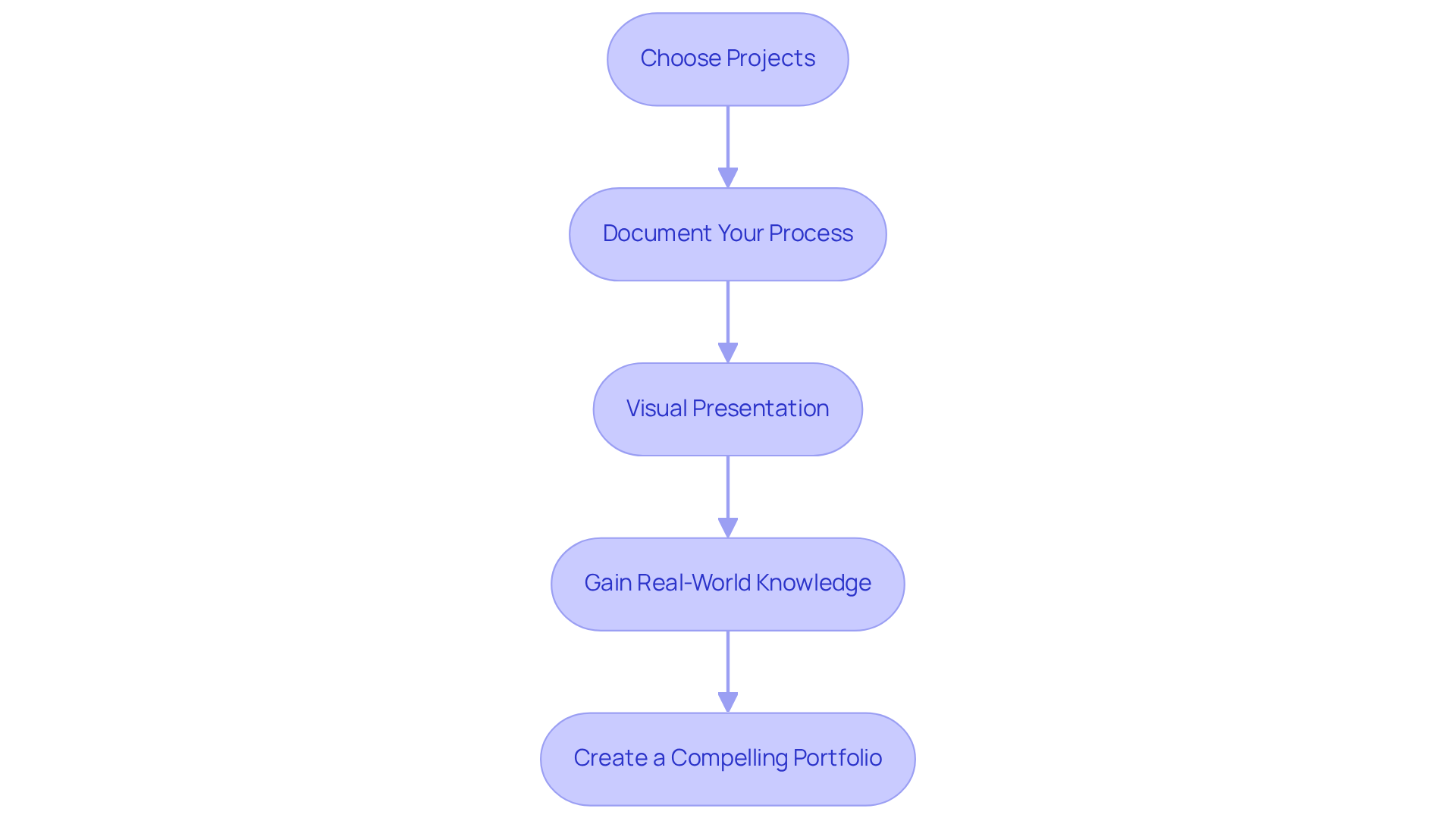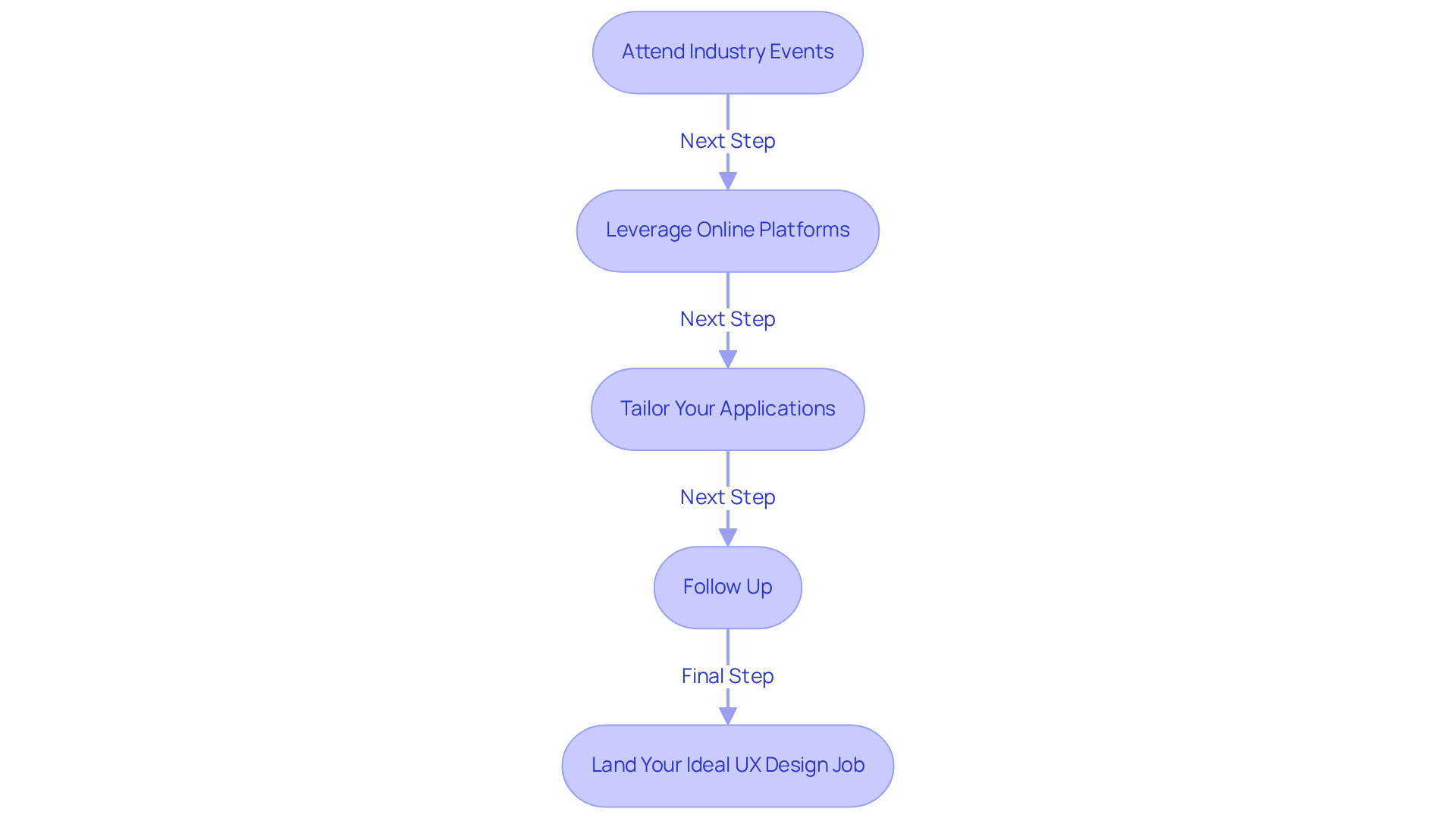Overview
Mastering user experience design jobs can feel daunting. Many aspiring designers struggle to find their footing in a competitive landscape, often feeling overwhelmed by the need to develop a user-centered approach and a diverse skill set. This struggle can lead to frustration, as the pressure to create a compelling portfolio that truly showcases one’s process and impact weighs heavily.
However, it’s important to remember that you are not alone in this journey. Effective UX design is rooted in empathy for users, collaboration with stakeholders, and a commitment to continuous learning about industry trends. These elements are not just buzzwords; they are the pillars of success in this field. By embracing a user-centered mindset and actively seeking out opportunities to collaborate and learn, you can transform your approach to UX design.
Consider sharing your experiences with peers or mentors who can offer insights and encouragement. Building a supportive network can make a significant difference in your growth and confidence. As you cultivate your skills and refine your portfolio, remember that every step you take is part of your unique journey. Embrace the process, and let your passion for user experience shine through in your work.
Introduction
In today’s digital landscape, where user experience can truly determine the success of a product, the role of a UX designer has never been more vital. As the need for user-centered solutions continues to rise, professionals in this field find themselves navigating a complex web of responsibilities.
From conducting research and creating prototypes to collaborating with diverse teams, the journey can be overwhelming. Many aspiring UX designers may wonder: what essential practices can they adopt to not only thrive in their careers but also create meaningful experiences for users?
This article explores key strategies and skills that will empower designers to excel in a competitive job market. By staying ahead of emerging trends and meeting the evolving needs of consumers, they can cultivate a fulfilling career that makes a real difference in people’s lives.
Understand the Role of a UX Designer
In today’s fast-paced world, many UX designers face the challenge of creating user-centered solutions that truly enhance the overall experience of a service or offering. This multifaceted role involves not just conducting research on individuals, but also developing personas, creating wireframes, and testing prototypes. It’s vital to promote the needs of users throughout the creation process, ensuring that the final outcome is not only practical but also a joy to engage with. Collaborating closely with product managers, developers, and other stakeholders is essential to harmonize client needs with business objectives.
The importance of empathy and customer advocacy in design choices cannot be overstated. Did you know that:
- 91% of dissatisfied clients choose not to voice their concerns?
- Companies that invest in customer experience can enjoy an astonishing return of $100 for every dollar spent, leading to a remarkable 9,900% ROI?
At RNO1, we understand these challenges deeply. Through our services, including Digital Strategy and Functional Prototyping, we aim to enhance user satisfaction and address these pressing issues. Recognizing these responsibilities and the impact of user-focused creation is essential for anyone looking to thrive in user experience design jobs. Together, we can that not only meet business goals but also resonate with the hearts of users.

Develop Essential Skills for UX Design
To excel in user experience design jobs, it's essential to cultivate a diverse skill set. Many professionals face the challenge of understanding participant needs, which can often feel overwhelming. Through methods such as interviews, surveys, and usability testing, we can bridge the gap between perceived and actual needs, revealing insights that significantly enhance design. It's heartening to know that 85% of participants indicated that research improved their item's usability, underscoring its importance.
Wireframing and prototyping can also seem daunting, yet developing both low-fidelity and high-fidelity prototypes allows designers to visualize concepts and iterate based on feedback. This process ensures that the final product aligns with expectations, fostering a sense of accomplishment.
Visual aesthetics play a crucial role as well. A strong understanding of principles, color theory, and typography is vital for creating visually appealing interfaces that attract individuals and enhance their experience. We all know how a beautiful interface can make us feel more connected to a product.
Moreover, organizing content effectively through information architecture is essential for improving usability and navigation. It helps users find information quickly and intuitively, alleviating the frustration of searching for what they need.
Collaboration and communication are key in this journey. Working effectively with cross-functional teams and expressing decisions clearly fosters a nurturing environment that drives innovation. We thrive when we .
As we navigate the evolving landscape of UX, keeping up with emerging trends—like the integration of AI in creative workflows and the anticipated rise in mobile device usage by 2025—becomes essential for maintaining relevance. The growing demand for consumer-focused items highlights that prioritizing research is vital for creating captivating and effective user experience design jobs.
Organizations that invest in consumer research often observe significant enhancements in usability, which can lead to better user experience design jobs and client satisfaction. This reinforces the idea that effective creation is not solely about appearances but about addressing practical issues. As Frank Chimero wisely stated, 'People overlook aesthetics that overlook individuals,' highlighting the necessity of a user-centric approach in all creative endeavors. Additionally, Scott Belsky's insight, 'Rule of thumb for UX: More options, more problems,' serves as a gentle reminder of the importance of simplifying selections for individuals—a relevant trend in UX today.
In this ever-changing field, let us embrace these insights together, nurturing our skills and supporting one another in our creative journeys.

Build a Strong Portfolio and Gain Experience
Creating a compelling UX portfolio can feel daunting, yet it is essential for showcasing your skills and attracting potential employers for user experience design jobs. Many designers struggle with how to effectively present their work for user experience design jobs, which can lead to frustration and missed opportunities. However, by following some key practices, you can transform this challenge into a powerful asset.
- Choosing Projects: Start by selecting 3-5 projects that truly reflect your creative process, problem-solving skills, and the tangible impact of your work. Consider highlighting diverse projects that illustrate your versatility and adaptability in various contexts. This not only showcases your range but also connects with the varied needs of potential employers.
- Documenting Your Process: It’s important to include thorough case studies that describe your method, from initial research and ideation to final creation and testing with participants. This documentation not only highlights your thought process but also underscores the significance of user-centered approaches, which are vital for securing user experience design jobs in today’s competitive environment. Remember, a staggering 90% of individuals have stopped using an app due to inadequate performance, highlighting the importance of addressing usability problems in user experience design jobs. Sharing these insights can resonate with others who have faced similar challenges.
- Visual Presentation: Your portfolio should be aesthetically pleasing and easy to navigate, reflecting your creative sensibilities. A well-crafted portfolio can significantly improve engagement; in fact, 75% of individuals assess a company's credibility based on its website design. This statistic underscores the necessity of a , which can help alleviate concerns about your professionalism.
- Real-World Knowledge: Actively seeking internships, volunteer opportunities, or freelance projects can provide invaluable practical skills. Statistics indicate that companies enhancing client interaction observe a 33% rise in customer satisfaction, emphasizing the importance of practical involvement in comprehending consumer needs and behaviors. Furthermore, 67% of mobile users are more inclined to purchase from a mobile-friendly site, highlighting the significance of developing user-friendly layouts. Engaging in creative challenges or hackathons can also provide valuable experience and networking prospects that are beneficial for user experience design jobs, further enhancing your portfolio and career development.
As Blake Ross, co-creator of Mozilla Firefox, wisely noted, "The next big thing is the one that makes the last big thing usable." This serves as a gentle reminder of the importance of usability in your projects. By embracing these practices, you can create a portfolio that not only showcases your talents but also connects with potential employers on a deeper level.

Network Effectively and Apply Strategically
To effectively , it’s important to recognize the challenges you might face and approach them with a nurturing mindset. The journey to landing your ideal role can feel daunting, but with the right strategies, you can build meaningful connections and enhance your visibility in the field.
- Attend Industry Events: Engaging in UX conferences, workshops, and meetups is not just about networking; it’s about building relationships with fellow professionals who understand your journey. As Brian Huang wisely noted, '60% of jobs are discovered through networking.' These events provide invaluable opportunities to learn about the latest trends and innovations in UX while connecting with others who share your passion.
- Leverage Online Platforms: Consider utilizing platforms like LinkedIn and creative communities to connect with fellow creators. By showcasing your work and seeking mentorship, you can cultivate an online presence that significantly enhances your visibility in the UX field. Remember, you’re not alone in this journey; many others are navigating similar paths.
- Tailor Your Applications: Personalizing your resume and portfolio for each job application is crucial. Highlighting relevant skills and qualifications that align with the specific role can greatly improve your chances of standing out to potential employers. This targeted approach shows your dedication and thoughtfulness, qualities that resonate well with hiring managers.
- Follow Up: After attending networking events, make it a priority to follow up with new connections. This simple act helps maintain relationships and demonstrates your continued interest in potential opportunities. As highlighted in the case study "Networking Is a Long-Term Strategy," effective networking requires time, sincerity, and effort.
By actively participating in the UX community and applying these strategic approaches, you can significantly boost your chances of landing your ideal user experience design jobs. It’s essential to avoid common pitfalls, such as directly asking for jobs, which can come across as shallow. Instead, focus on building genuine relationships and offering value first. Remember, you are part of a community that supports and uplifts one another, and together, you can navigate this journey with confidence.

Conclusion
Mastering user experience design jobs can feel daunting, often leaving aspiring designers overwhelmed by the multitude of skills required. This challenge can stir feelings of uncertainty, especially when one considers the competitive nature of the industry. Yet, at the heart of successful UX design lies a nurturing approach that emphasizes empathy, collaboration, and continuous learning, guiding designers to not only meet business objectives but also resonate deeply with users.
Key insights reveal that developing essential skills—such as research methodologies, wireframing, prototyping, and visual aesthetics—is vital. Building a robust portfolio and gaining practical experience are crucial steps that can significantly enhance a designer's employability. Networking effectively and applying strategically can open doors to new opportunities, making it essential to engage with the UX community and personalize applications for each role.
In this ever-evolving field, staying informed about current trends and embracing user-centered practices will be instrumental for UX designers seeking success. While the journey may seem challenging, fostering connections and honing skills can empower professionals to navigate the landscape of user experience design with confidence and purpose. By embracing these essential practices, individuals can elevate their careers and contribute to creating impactful and engaging user experiences that truly stand the test of time. Together, let’s nurture our skills and support one another in this exciting journey.
Frequently Asked Questions
What is the primary role of a UX designer?
The primary role of a UX designer is to create user-centered solutions that enhance the overall experience of a service or offering, which includes conducting research, developing personas, creating wireframes, and testing prototypes.
Why is empathy important in UX design?
Empathy is crucial in UX design as it helps designers advocate for the needs of users, ensuring that the final product is practical and enjoyable to engage with.
How do UX designers collaborate with other stakeholders?
UX designers collaborate closely with product managers, developers, and other stakeholders to harmonize client needs with business objectives throughout the creation process.
What statistics highlight the importance of customer experience?
Notably, 91% of dissatisfied clients choose not to voice their concerns, and companies that invest in customer experience can achieve an ROI of $100 for every dollar spent, resulting in a remarkable 9,900% ROI.
What services does RNO1 offer to enhance user satisfaction?
RNO1 offers services such as Digital Strategy and Functional Prototyping to enhance user satisfaction and address challenges in user experience design.
What is essential for thriving in user experience design jobs?
Recognizing the responsibilities and impact of user-focused creation is essential for anyone looking to thrive in user experience design jobs.




